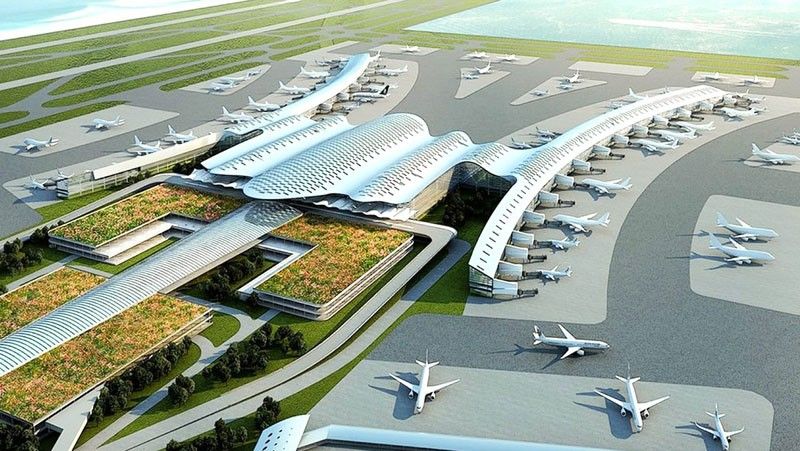Alternatives to NAIA: From Sangley to Bulacan

(Second of three parts)
MANILA, Philippines — There’s no lack of plans for new airports that could serve as alternatives to the congested Ninoy Aquino International Airport (NAIA).
Sangley Point International Airport
One such airport project is the Sangley Point International Airport in Cavite.
The provincial government of Cavite, together with project development management Cavitex Holdings Inc., CFP Transaction and design consultants Arup and NATS, the UK national Air Traffic Service Provider, is the proponent of the planned Sangley Point International Airport.
The group has tapped Munich Airport as operational technical partner, a move that bodes well for the project given the track record of Munich Airport – touted as Europe’s Best Airport by the London-based Skytrax for 12 years now.
The first phase of the Sangley Airport project, with an estimated total cost of roughly $3 billion, will have one runway that will operate alongside NAIA. It has a designed capacity for 25 million passengers annually, project documents obtained by The STAR showed.
The second runway will take over capacity from NAIA, with a designed capacity for 75 million passengers annually.
The airport is designed to expand with four runways, with capacity for 135 million passengers annually.
According to published reports, the project’s first phase is slated for completion in 2022, while the second phase is targeted for completion in 2028.
Proponents said the massive airport project would significantly reduce traffic in Metro Manila as passengers will not need to go through EDSA and there would be new road projects connecting to Sangley. They said that it would complement the existing Clark International Airport in the north.
The proposal comes at a time when NAIA is at extreme over-congestion and cannot meet future demand growth with its maximum design capacity at only 35 million passengers.
Sangley has also been recommended by the Japan International Cooperation Agency as the best option for a new airport out of nine pre-selected sites.
New Manila International Airport
Another airport project is tycoon Ramon Ang’s P740-billion New Manila International Airport (NMIA) in Bulakan, Bulacan.
Ang, a licensed pilot and an aircraft enthusiast, has long been stressing the need for a new airport in the country.
According to its blueprint, NMIA has the capability to have a total of four runways, with the first two already operational on the fifth year upon approval of the project, according to company documents.
To be developed on a 2,500-hectare property in Bulakan, Bulacan, NMIA can accommodate 100 million to 200 million people, a far cry from NAIA’s capacity of 35 million passengers.
Furthermore, NMIA will be capable of handling 60 aircraft movements per hour per runway compared to NAIA’s current runway capacity of 45 movements per hour, the project’s blueprint showed.
More importantly, Ang said the NMIA project cuts the construction timeline by half as it would not require sea reclamation compared to the Sangley Airport project.
As for the funding, San Miguel Corp. will fund the project and it would be at no cost to the government, said Ang, president and COO of SMC.
In terms of contribution to the economy, SMC estimates that NMIA can contribute as much as P395 billion to the economy by 2025 and can generate 1.8 million jobs by that time.
Along with the airport, Ang also plans to build an MRT Loop with an airport express – similar to Hong Kong’s much-touted MTR that would seamlessly connect Metro Manila to the planned aerotropolis in Bulacan.
The elevated train system will span some 200 kilometers and will connect NMIA in Bulakan, Bulacan to EDSA and various points in between, Ang said.
While the stations are still being finalized, the MRT Loop is envisioned to include a non-stop high-speed train that would allow fast connection between EDSA and the Bulacan Airport.
“In 20 minutes, you will be at the airport,” Ang said.
He said this would be something like Hong Kong’s famous MTR which connects the airport and the city, and which gives passengers the option for faster travel through the airport express line.
The NMIA project is moving.
On Dec. 15, SMC announced that it has chosen a Dutch firm to start land development for NMIA, which is set to begin in the first quarter of 2021.
The $1.73-billion contract, or around ?83.2 billion, was awarded to Royal Boskalis Westminster N.V., through its wholly owned subsidiary Boskalis Philippines Inc. to start preparation works at the site of the airport in Bulakan town.
Clark Int’ Airport
Aside from Sangley and Bulacan airports, another alternative gateway to NAIA is the Clark International Airport, whose operations and maintenance contract has been awarded to the North Luzon Airport Consortium of Gotianun-led Filinvest Development Corp, the Gokongwei’s JG Summit Holdings Inc, Philippine Airport Ground Support Solutions Inc, and Changi Airports Philippines, a wholly owned subsidiary of Changi Airports International.
Luzon International Premiere Airport Development Corp. (LIPAD), a special purpose entity established by the consortium, will operate and maintain the airport under a 25-year concession contract.
LIPAD will also develop the airport’s commercial assets, operate and maintain project facilities, and fit-out the new terminal, which is under construction.
Multi-Airport
The Japan International Cooperation Agency recommends a dual airport system for the Greater Capital Region, with Sangley International Airport replacing NAIA to service the southern catchment, and Clark International Airport to service the northern catchment.
Transportation Secretary Arthur Tugade also believes in a multi-airport strategy, saying it would support and would likewise be supported by the country’s future economic growth.
But these alternatives will take years to build and while Filipinos are waiting for these airports to be operational, the fact remains that NAIA needs an upgrade.
- Latest
- Trending



























